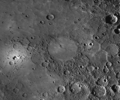Fichier:Copland crater.png

Taille de cet aperçu : 723 × 600 pixels. Autres résolutions : 290 × 240 pixels | 579 × 480 pixels | 926 × 768 pixels | 1 235 × 1 024 pixels | 2 272 × 1 884 pixels.
Fichier d’origine (2 272 × 1 884 pixels, taille du fichier : 2,5 Mio, type MIME : image/png)
Historique du fichier
Cliquer sur une date et heure pour voir le fichier tel qu'il était à ce moment-là.
| Date et heure | Vignette | Dimensions | Utilisateur | Commentaire | |
|---|---|---|---|---|---|
| actuel | 17 décembre 2010 à 20:40 |  | 2 272 × 1 884 (2,5 Mio) | LobStoR | reduced palette from 24-bit RGB to 8-bit greyscale |
| 30 avril 2010 à 09:44 |  | 2 272 × 1 884 (4,6 Mio) | Bryan Derksen | {{Information |Description={{en|1=Instrument: Narrow Angle Camera (NAC) of the Mercury Dual Imaging System (MDIS) Scale: Copland crater has a diameter of 208 kilometers (129 miles) Projection: This image is a portion of the NAC approach mosaic from Mercur |
Utilisation du fichier
La page suivante utilise ce fichier :
Usage global du fichier
Les autres wikis suivants utilisent ce fichier :
- Utilisation sur ca.wikipedia.org
- Utilisation sur en.wikipedia.org
- Utilisation sur en.wikibooks.org
- Utilisation sur es.wikipedia.org
- Utilisation sur it.wikipedia.org
- Utilisation sur www.wikidata.org
- Utilisation sur zh.wikipedia.org


